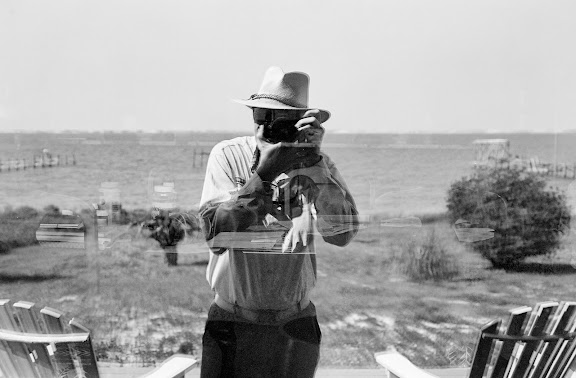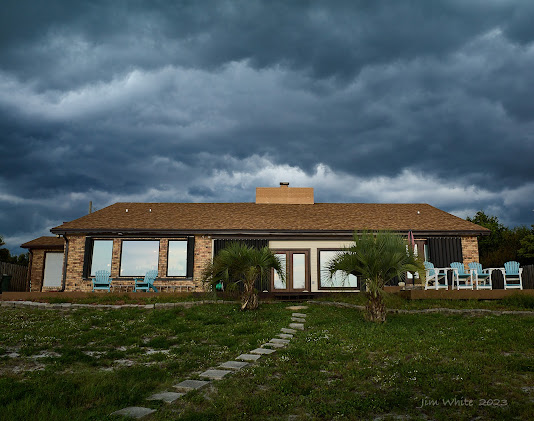Last week I loaded a roll of Ilford's FP4 into the Yashica Mat 124G to capture images of Big Lagoon skies. On any given day the skies can go from white puffy clouds to angry grey clouds to humid haze to clear in the course of just a few hours. Regardless of the sky, I am frequently faced with a high dynamic range situation. Dark ground in the foreground and bright sky in the background. Depending on how I set exposure, my highlights can be too bright or the shadows too dark. Hold that thought.
Recently, I've been studying the Zone System. Developed by Ansel Adams and Fred Archer in the late 1930s, the system defines 11 "zones" from pure black with no texture (Zone 0) to pure white with no texture (Zone XI). In the center at Zone V is "middle grey." Light meters return an exposure value based on middle grey (Zone V). The meter does not know the color of the subject. It only knows the value of light reflecting off the subject. That means metering the bright white wedding gown of the bride will return an exposure value based on the meter thinking the gown is middle grey. This will under expose the gown and it will look grey in images. Conversely, metering the groom's black tuxedo will return an overexposed and grey tuxedo because the meter is calibrated to regard all subjects as middle grey. Knowing this, we overexpose the image of the bride's gown (to make it white) and underexpose the image of the groom's tuxedo (to make it black). This yields the results we're looking for. Of course, how much to overexpose or underexpose is the up to the photographer and their level of experience. This is easier in 2023 as most folks are shooting with mirrorless digital cameras which provide instant feedback. Not right? Adjust exposure and shoot another image.
It is a different matter for film and again, this is where the experience of the photographer comes into play and where a bit of knowledge of the Zone System can help. Each of the eleven steps in the system are one stop difference. Zone V to Zone VI, add one stop of exposure to make the image one stop brighter. Zone IV to Zone III, reduce one stop to make the image one stop darker. Perhaps you want the bride's gown in Zone VII. Add two stops to whatever the light meter provided as the exposure. Perhaps you want the groom's tuxedo in Zone III. Reduce the metered exposure by two stops.
Adams and Archer took this system to the Nth degree and wrote five books on the topic. The two key books regarding dealing with dynamic range were The Negative and The Print. It is in these pages where the idea of exposing the in-camera image for the most important shadow area, then developing the negatives in such a way as to bring down the highlights. In this way we get the best of both worlds, properly exposed shadows AND highlights.
Note: I'm not an expert, just an amateur photography who's done a bit of reading on the subject. Hopefully my explanations are at least partially correct.
This leads me to today's post. The idea of the roll of FP4 was to experiment with the "expose for the shadows and develop for the highlights" concept. Turns out easy to explain the process, more challenging to put into practice. Ideally, after you determine what is the important shadow area (that shadow area where you want to see texture and details), you spot meter for that area. Knowing the meter yielded a Zone V exposure, you determine to put that shadow area into either Zone IV (one stop less exposure) or, more likely, Zone III (two stops less exposure). This reduction in exposure to get the shadows right also reduces exposure in the sky by the same amount. On some days this may be all that is needed to tame the. bright sky highlights. On other days the tonal range may still be too much. In those cases, "developing for the highlights" means developing the negative for less time. As will determining exposure for the shadows, experience doing this helps.
A review of the internet provided a lot of information to get me started and in the end I elected a 15% reduction in development time as I didn't think the dynamic range in the images was too much and the reduction in exposure to account for the shadows helped out with the highlights. To achieve the 15% reduction without having to do public math, the Massive Dev Calculator is a huge help and highly recommended. I have it loaded on my iPad and iPhone. Reductions or additions to recommended development times are easy to dial in. Again, knowing how much to dial in requires experience - Google recommends somewhere between 15%-25% to get started.
The shadow areas in a negative are fully developed by the halfway point of the total recommended developing time. In this case, I developed FP4 (exposed at box speed) in HC-110 at 1+47 dilution at 24C and that yielded a recommended developing time of 7:22. This means that, generally speaking, the shadow areas were fully developed a little over three and a half minutes into the process. Regarding reducing development time, guidance is to not reduce time below the mid-point of the recommended processing time. Inputing "-15%" into the Massive Dev Calculator gave me a total development time of 6:15. In theory this produced well exposed important shadow areas and well exposed highlights.
Below are two of the images produced in this process. They were shot a few days apart in very different lighting conditions. In both cases I had the shadow detail I sought, without blowing out the highlights. Film has much more latitude where highlights are concerned, and it is true that dynamic range on both days was well within the latitude of the film. That said, I could see more details in the clouds prior to scanning the negatives. More than I had seen in similar instances of the same scene. The two images below were scanned to be neutral and were then imported into Capture One for digital processing. The sky details, while not as dramatic as shown, were there. Further processing in Silver Efex Pro 3 resulted in the final look I sought for both images.
This was my first experience with reducing developing time to control highlight exposure. Certainly it was not scientific. However, it gave me the confidence to experiment further and the next roll will be shot on a bright, overhead sun summer day with high dynamic range between shadows and highlights. And, I will experiment in a further development time reduction to see how far I can go and still be happy with the images.
Yashica Mat 124G and Ilford FP4









